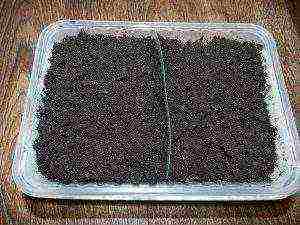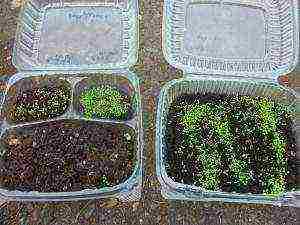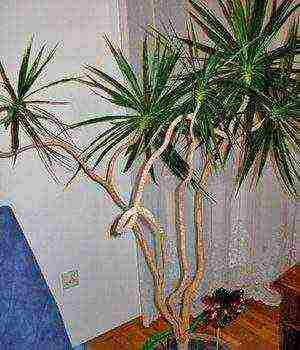Content
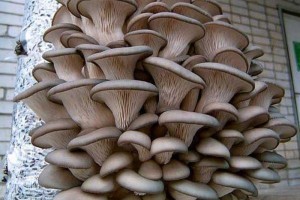
Until recently, oyster mushrooms were considered a delicacy, but today you can enjoy them all year round.
Everything you need: a room free from human habitation, material for growing and full care, observing which, in a few weeks you can harvest the first harvest of oyster mushrooms.
After reading our article, you will learn how to grow oyster mushrooms with your own hands, what nuances of care are important for breeding them, what is the best way to harvest and where to store it.
Where to grow oyster mushrooms
Oyster mushrooms are usually grown in cellars, basements, in greenhouses, at home - in principle, any non-residential premises are suitable for this, although many mushroom pickers claim that growing oyster mushrooms in an apartment is dangerous to health.
For the growth of fungi, high humidity is necessary, creating which, you risk not only your own health (allergic cough, high body temperature), but also damage your own home (mold on the walls).
An ideal place for sowing and growing oyster mushrooms is a greenhouse. But, even there, the production of mushrooms is a daily hard work and control over the process.
If you decide to grow oyster mushrooms on your own in artificial conditions at home, remember to thoroughly disinfect the room. To do this: treat the walls and floor with a 4% bleach solution, and after two days, ventilate it.
The main stages of breeding oyster mushrooms
The process of breeding oyster mushrooms includes several stages:
Preparation and processing of the substrate
The substrate is a breeding ground for the growth of fungi, a kind of soil. As a raw material for the substrate, you can use, for example, sunflower husks, fresh straw, buckwheat husks. The main condition for cooking is clean material.
It is better to grind the substrate. To avoid the ingress of harmful microorganisms and foreign particles into it, the substrate is treated with steam (heat treatment). For this: the substrate (for example, take 10 kg) is placed in a container and heated.
Cook the substrate for two hours in a row. Next, drain the water and cool the substrate to a temperature of 25 ° C. The most common technology for processing a substrate today is xerothermal technology.
The essence of this process is that the substrate under the influence of steam is heated to 100 ° C and kept for a certain amount of time (1.5 hours in the case of using straw). After the specified period, the substrate is moistened with water.
Formation of mushroom blocks
Mushroom blocks are polyethylene bags with a size of 350x800 mm, filled with a substrate. For their formation, the substrate and mycelium (mycelium) are placed in layers in the packages pre-treated with steam, alternating between them. You can easily buy mycelium on the Internet.
The top layer is a substrate. After filling, the bag is tied. Next, we make small holes (1-2 mm) in the bag, leaving a distance of 10 cm between them.
Seedling care
After the formation of mushroom blocks, the incubation period begins (the period of oyster mushroom maturation). At this stage, it is important to create proper oyster mushroom care. Monitor the temperature in the bags (the optimum temperature is + 20 ° C).In addition, the room must be ventilated.
Incubation lasts 2-3 weeks, after which the overgrown mycelium is transferred to another room (nursery room) for growing.
Fruiting
On the 7-10 day after transferring the mycelium to a new room, the first rudiments of fungi appear. At this stage, it is important to increase the air humidity to 100%... For this, the floor and walls of the room are sprayed with water. You need to ventilate the room even more often.
And also, mushrooms need lighting before 10 hours a day. Additional lighting can be created using ordinary fluorescent lamps.
Harvesting
It is believed that the correct harvest is the twisting of oyster mushrooms from the substrate. The fact is that when cutting them with a knife, there is a risk getting into the mycelium of microorganisms.
In one room you can spend 4-5 rotations (continuous cultivation) for a year.
Note! After harvesting, the premises are washed with water, disinfected and thoroughly ventilated.
Growing methods
We examined the technology of growing oyster mushrooms, now we will dwell on its methods in more detail. Consider two of the most popular and, as practice shows, effective methods of artificial cultivation of oyster mushrooms:
- Extensive method - in natural conditions;
- Intensive method - growing in a special room using a substrate.
Extensive cultivation methods
Oyster mushrooms can be grown in this way on sawdust, shavings, on stumps left in the forest, after tree felling, as well as on fruit-bearing garden trees.
Instructions for the extensive method of growing oyster mushrooms on stumps:
- Preparing the stump for planting oyster mushrooms. The diameter of the stump is 20-40 cm, the length is 30-40 cm. It is best to use a freshly cut stump;
- We set the stump in a small depression, on the bottom of which we lay the substrate (for example, wheat). We also add mycelium (seed) there;
- Place the prepared stump in the recess and cover it with soil.
From time to time, the stump needs to be watered. No other maintenance work is required. The crop can be obtained in the same season when planting was carried out. It is best to plant mushrooms in the spring.
You can also grow oyster mushrooms using wooden blocks. For this:
- We prepare the bars. To do this, we cut them off from a freshly cut hardwood tree. We soak them in water for a week;
- We put the bars on top of each other, and on the end of each we pour the mycelium (mycelium) about 100-150 g. Another way to introduce the mycelium is to drill small holes (10-12 mm) in the bar;
Recommendation! The diameter of the finished bars should be 20-40 cm. The length of each bar can be up to half a meter.
- We wrap the bars with cellophane wrap to prevent the mycelium from drying out;
- On the sides of the bar we make holes with a diameter of 10-12 mm for the mycelium. We cover them with moss, wet sawdust or straw. 10 holes should be enough.
Instructions for growing oyster mushrooms on sawdust:
- We fill up the substrate (nutrient medium) with a layer of 10-15 cm in a previously prepared trench and spray it with a suspension of "mushroom spores" for better reproduction of oyster mushrooms. The depth of the trench should be 15-20 cm. Width - 40-60 cm;
- We prepare the wells for the introduction of the mycelium. The depth of the holes is 5-7 cm. We put 10-20 grams of mycelium in them;
- We cover the holes with branches, cover with polyethylene film and pour a small layer of earth on top.
The first harvest can be expected after 2-3 months.
Intensive cultivation methods
For growing oyster mushrooms in an intensive way, the substrate is important. As a substrate, sawdust from trees, cereal straw or sunflower husks can act.
Let's consider the most common technology for artificial cultivation of oyster mushrooms in bags.
This process consists of the following steps:
- Chopped straw is poured into a large tank and filled with water;
- Then a fire is made under the tank.While the straw is "boiled" at a temperature of 70-80 degrees for 8-12 hours, purchased plastic bags are prepared or made from a plastic sleeve. Bags are used in sizes 40 by 60 cm or 50 by 100 cm;
- The water is drained from the tank. The straw is placed in bags and stacked in layers, alternating each layer of straw with a layer of mycelium. At this stage, you can add 10% bran. An obligatory component of the substrate is a 1-2% bioactivator (slaked lime);
- Small holes are made in bags with mycelium (diameter 2 cm). The bag itself is filled with a substrate for 2/3 of the volume;
- The necks of the bags are tied with a rope and set in an upright position;
- Watering the bags is carried out. Moreover, the first 5 days, watering is carried out with extreme caution - it is important to prevent water droplets from falling on the bags. Then - using a hose at least twice a day.
Important! The air humidity in the room where the oyster mushrooms grow should be 90-100%.
General growing conditions exist for the normal growth of mycelium. Pay attention to them:
- The mycelium can be sown when the substrate cools down to a temperature of +22 degrees, it easily crumbles and does not stick to the hands;
- The mycelium is introduced at the rate of 150-180 grams of mycelium per one mushroom block (6-8 kg of substrate).
Oyster mushroom care rules
To effectively grow oyster mushrooms at home and get a harvest, you must follow the generally accepted rules:
- The room temperature should be + 22-25 degrees;
- The temperature of the contents of the bag itself should be +28 degrees;
- Indoor air humidity - 90-95%. For this, several cans of water can be installed in the room;
- There must be good ventilation between the bags. They can be stacked on specially made racks or hung from the ceiling;
- Growing temperature should be reduced to + 12-18 degrees;
- For half a day, the room should be illuminated with fluorescent lamps;
- Good air flow is the key to an excellent harvest. If the room is small, you can install ordinary fans and open windows and doors more often. But for rooms with large areas, ventilation with special equipment is needed;
- In rooms where oyster mushrooms are grown, it is advisable to wear protective masks. The mask will help prevent allergies and the associated suffocating cough;
- An irrigation system is indispensable. Oyster mushrooms are moisture-loving mushrooms. Remember to water them twice a day.
Oyster mushrooms are a delicious, nutritious and natural product. But their main advantage is profitability, i.e. ease of growing. By the way, you can cultivate these mushrooms both for yourself and for sale. The main thing is to master the cultivation technique and put a little effort into it.
You will learn more about how to grow oyster mushrooms at home from this video.:
Rate the article
(
estimates, average:
out of 5)
It will be about tasty, healthy, unpretentious mushrooms, how to grow oyster mushrooms at home, about all stages of this process. After all, we all eat mushrooms with pleasure, we love to wander through the forest, collecting them, but if there are suitable conditions, interest, a great desire, then it is quite possible to grow mushrooms ourselves. It is worth noting the amazing adaptability of oyster mushrooms: they can grow on stumps, on tyrsa (sawdust), even on paper. They don't need soil. They are characterized by fast fruiting - 1-1.5 months.
Choosing a room and preparing a substrate
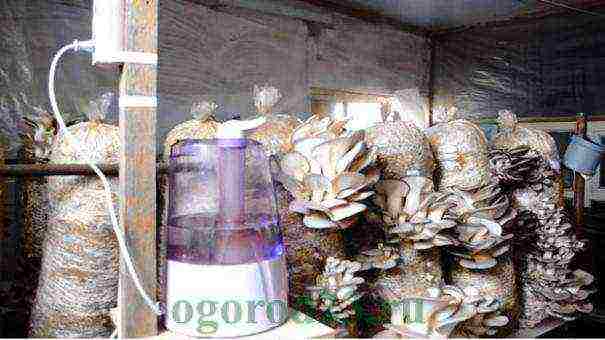
To grow oyster mushrooms, it is necessary to equip a non-residential place in advance. For these purposes, basements, garages (in which there are no cars), cellars, sheds or rooms specially equipped for these purposes are excellent. Before starting any preparatory work, it is necessary to decontaminate the place where we will grow oyster mushrooms.
A lime solution (4%) will do this well. Floor, walls, ceiling - all available surfaces must be thoroughly disinfected, and then the room must be closed for a couple of days.After the specified time has elapsed, you need to open the doors wide open and thoroughly ventilate this place until the smell of lime completely disappears.
The technology of growing oyster mushrooms at home implies the choice of the material most suitable for these purposes. The substrate creates optimal conditions for growth: it can be wood chips, corn stalks, buckwheat or sunflower husks, and cereal stalks. Large fragments of the substrate on which we will grow oyster mushrooms should be finely chopped.
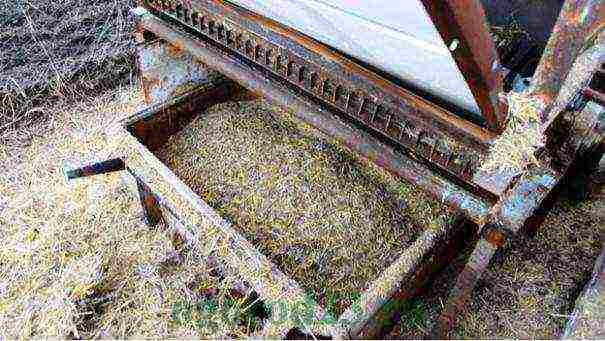
Any material you choose needs processing - pasteurization:
- Fill the substrate with warm water, not hotter +23 .. + 25 ° С, holding time - 20-30 minutes. At the same time, stir the mixture in a container, as if washing it from dirt.
- We drain the dirty water, squeeze out the material and re-fill it with hot water (+80 .. + 90 ° С) and press it down with a heavy object (under oppression). We leave the substrate like this for 6-7 hours, after which we drain the water and finally squeeze it out.
- To increase the productivity of the material and subsequent fruiting, it is necessary to saturate the substrate with active elements. Superphosphate, gypsum, limestone and urea are taken in a proportion of 0.5%: 2%: 2%: 0.5%.
- During the "fertilization" of the substrate with additives, its moisture content should be about 70% - this will allow the chemical elements to stay inside the mixture, not to leak out with water.
After the room is prepared and disinfected, and the substrate is pasteurized, it is the turn of laying the mycelium into the mixture. You can buy oyster mushroom mycelium in the mycological laboratory. You can choose the best quality product from the wide selection of commercial varieties of mushrooms. Specialized online stores are also at your service.
Pre-calculate the volumes - for sowing a 10-kilogram block, you will need 200-250 g of oyster mushroom mycelium (if it is of imported origin) or 100 g more if the raw material is domestic.
↑ to the table of contents ↑ How to grow oyster mushrooms at home step by step
The mycelium is added to the substrate at the rate of 300-500 g per 10 kg of the mixture. In this case, it is necessary to ensure that the temperature of the material at the time of adding the mycelium does not exceed + 30 ° C (so as not to ruin the raw material).
This is followed by the preparation of bags for laying the mixture and oyster mushroom mycelium. For these purposes, it is very convenient to use dense plastic bags and bags. Sizes 40 × 60 cm and 50 × 100 cm are the most optimal. We lay out the resulting composition in bags and carefully twist them, while there should be no air inside.
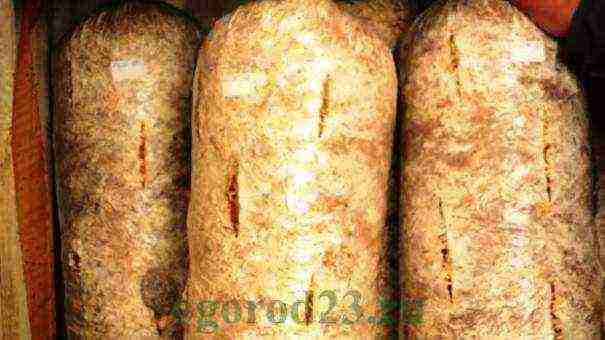
We make holes in the blocks with a knife. The incisions should be located arbitrarily - at a distance of 10-15 cm from one another. After the performed manipulations, the bags are stacked on top of each other (2-4 pieces each) or suspended on special hooks pre-installed in the ceiling or walls. There should be a distance between the bags to ensure comfortable air circulation.
Also, for growing oyster mushrooms, it is very convenient to use special wooden stakes on a stable basis - blocks with a substrate are simply strung on them in several pieces.
Growing oyster mushrooms at home in bags involves maintaining a certain temperature and light conditions. Thus, for full germination, mushrooms require a temperature level of about +18 .. + 24 ° С along with high humidity (90-95%).
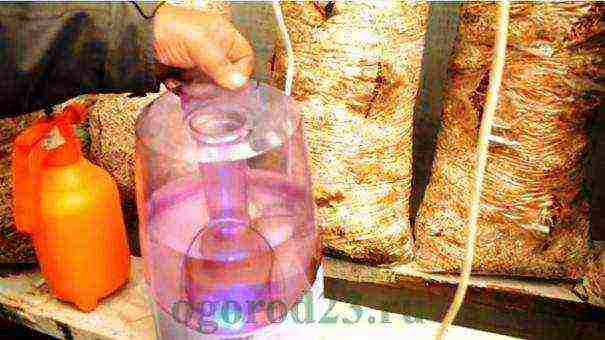
Sometimes, for additional humidification, buckets of water are placed between the rows of bags, and the necessary air exchange is maintained with the help of fans. Ventilation is important in this case - the excessive release of carbon dioxide inhibits the growth of oyster mushrooms. No light is needed during the incubation period. Make sure that flies do not enter the room at all stages of growing and fruiting.
Growing oyster mushrooms at home includes an incubation period of approximately 14-17 days.
In the first days, the temperature inside the blocks rises, make sure that it does not exceed the level of + 30 ° С. If the temperature is about to reach a critical point, direct the running fan towards the bags. As mentioned above, such an indicator (elevated temperature) is detrimental to the mycelium. At the end of the incubation period, the blocks are covered with a white coating - this is where oyster mushrooms begin to sprout.
Growing at this stage involves maintaining certain conditions indoors:
- humidity of air - at least 80%, and preferably up to 90-95%;
- air temperature at the level of +12 .. + 17 ° С;
- the required 8-hour lighting is 100-170 lux (as on a cloudy day), ordinary day lamps will do;
- frequent ventilation.
It is possible to maintain humidity by sprinkling the walls and floor with a spray bottle, but the water should not get onto the blocks. This fruiting period lasts about 2 weeks; by the end of the term, the caps of the oyster mushrooms become quite large.
It's harvest time. In this case, you do not need to cut off the myceliums with a knife, but carefully twist them out of the bag with the substrate. After the first removal of the oyster mushroom, you should thoroughly ventilate the room and wait for the second round of fruiting.
The first harvest is the largest, the second is slightly smaller, the third is less than the second - that is, the yield waves follow each other in decreasing order.
The rest period between the "waves" is 8-10 days, and the "waves" themselves can be 4 or even 6.
The substrate, which has already served its term, becomes an excellent fertilizer for summer cottages.
↑ to the content ↑ How to grow oyster mushrooms at home on stumps
An excellent option for owners of summer cottages is the method of growing oyster mushrooms on stumps - this method does not require excessive efforts. For these purposes, it is better to choose freshly cut hemp, but you can also prepare it in advance. They should be placed in shaded areas where there is no access to sunlight, for example, under spreading tree crowns or under vineyards.
Stumps need to be soaked in water and kept for about 3-4 days, older specimens - a week. Then, using a drill (20-25 mm), you need to drill 8-10 holes 7-10 cm deep. These depressions are then filled with oyster mushroom mycelium, the top is covered with clay or clogged with moss.
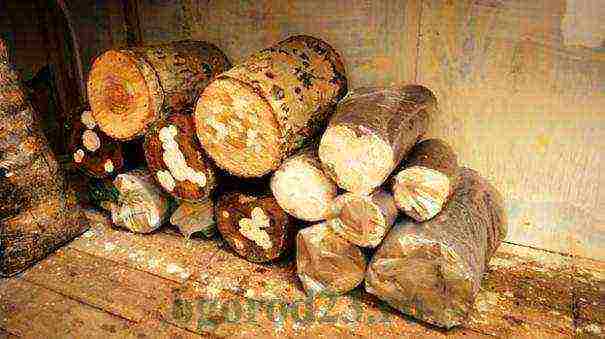
The stumps must be constantly moist, for this they can be covered with cling film and placed in the basement for a month and a half. When the stumps are overgrown with mycelium (in appearance something like a white film), they can be taken out into the air, placed in shady places.
Studying the possibilities and options for ways to grow oyster mushroom at home, it should be recognized that this method does not require excessive efforts, it is ideal for the owners of summer cottages.
Important information - a prerequisite is the use of respirators and protective masks when working with mycelium, as well as during fruiting! If it enters the respiratory tract, fungal spores can seriously harm your health.
In this matter, commitment and patience will be required of you. Mushroom growing is truly a fun and rewarding activity. The topic of how to grow oyster mushrooms at home finds more and more fans among summer residents and enthusiastic gardeners. In addition to the presence of this tasty and rich product on the dinner table, the cultivation of oyster mushrooms is an interesting and profitable business. Try and grow oyster mushroom at home - a rich harvest for six months will undoubtedly please you.
Oyster mushroom grows only on dead deciduous wood (aspen, birch, poplar, etc.) and therefore does not pose a danger to living trees in the garden. It usually appears on wood in the form of large aggregates, in which up to 30 individual mushrooms can be counted, and the weight of such aggregates reaches 2-3 kg.Oyster mushroom is widespread in nature and in the middle lane bears fruit all summer and autumn. Especially massive fruiting occurs (depending on the air temperature) in August - October.

Types of oyster mushrooms
Oyster mushroom is much easier to cultivate than champignon, and its taste is not inferior to it. It can be eaten fresh, fried, stewed, or in soups. The mushroom does not lose its taste and is well preserved when dried and pickled.
Extensive growing method. Oyster mushroom has long attracted the attention of mushroom growers, since its artificial cultivation on wood waste does not require large material costs. Its methods are well developed. A simple, reliable and cheap - extensive cultivation is most suitable for a personal plot. It should be carried out in two stages.
At the first stage, pieces of hardwood (aspen, birch, poplar, etc.) are harvested with a length of no more than 25-30 cm and a diameter of at least 15 cm2: thinner pieces give a lower yield. To give the wood the appropriate moisture content necessary for the normal development of mycelium, it is soaked in water for one to two days.
At the end of winter or early spring, the segments are placed in cellars, basements or other closed rooms one on top of the other, bringing the height of the column to 2 m. It is formed as follows. On the upper ends of each piece of wood, a grain oyster mushroom mycelium is applied with a layer of at least 1-2 cm, the next segment is placed on it, on the upper end of which the mycelium is also applied, and so on up to 1.5-2 m. The consumption of mycelium is 70-100 d for one segment.
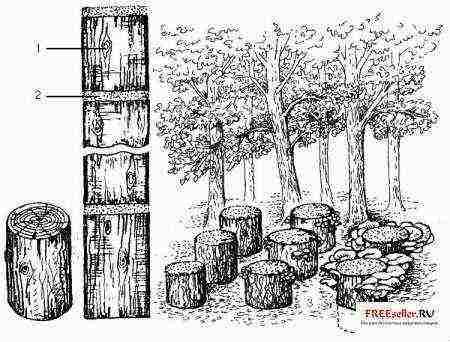
Growing oyster mushrooms in an extensive way: 1 - a piece of wood; 2 - grain mycelium between segments; 3 - placement of pieces of wood on the site under the canopy of trees.
All columns are covered with a layer of straw on top, which contributes to the preservation of moisture and better development of the mycelium, which gradually penetrates the wood. For shelter, you can also use matting, burlap, but not plastic or other films: they do not let the air in which the developing mycelium needs.
The growth of wood with oyster mushroom mycelium at a temperature of 10-15 ° C occurs within 2-2.5 months. The air in the room where the pieces of wood are located must be humidified, but at the same time it is necessary to ensure that water does not get on the wood.
Unlike champignon, oyster mushrooms need light for fruiting, so the second stage of oyster mushroom cultivation in central Russia usually begins in May. The pieces of wood overgrown with mycelium are placed in the ground in the open air. In this case, each of the segments with one side is deepened by 10-15 cm, placing them in rows under the canopy of trees or in other shaded places.
The distance between the segments in the rows and between the rows is 35-50 cm. Light artificial sheds can also be used for shading.

Fruiting plantation.
Plantation maintenance consists of gentle watering of the soil in dry weather. Mushrooms usually appear in August - September, and oyster mushrooms bear fruit throughout October. When collecting, the mushrooms are carefully cut. On average, from one piece of wood during the first harvest, you can get more than 600 g of excellent mushrooms that form large intergrowths. Plantations are left to winter in the same place. In the second year, under favorable conditions, each segment can produce 2-2.5 kg of mushrooms. With this method, an average of 20 kg of mushrooms per year appears per 1 m2 of wood, with the largest harvest being harvested in the second and third years.
You can also grow oyster mushrooms in greenhouses. In this case, the segments in October-November are placed in the soil in the greenhouse, deepening into the soil, as indicated above. This excludes the installation of columns.
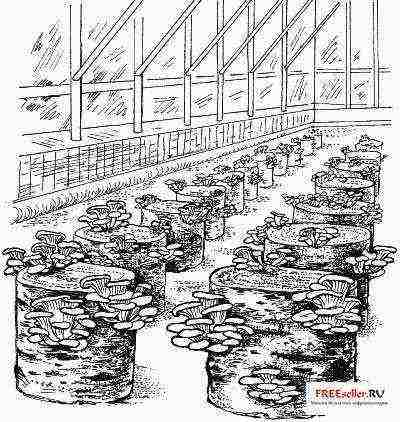
Growing oyster mushrooms extensively in a greenhouse.
At the same time, the segments are infected with grain mycelium. The mycelium applied to the ends of the segments must be covered with wooden discs 2-3 cm thick and with a diameter equal to the diameter of the segment.Growing in a greenhouse allows you to regulate the microclimate (humidity and temperature of air and soil) and creates more favorable conditions for fruiting. The growth of mycelium segments here lasts 1-1.5 months at an air temperature of 13-15 ° C, a soil temperature of 20-22 ° C and a relative air humidity of 95-100%. It is these conditions that must be maintained in the greenhouse during the growth of mycelium in the wood.
When the mycelium grows, the air temperature in the greenhouse is lowered to 0 or +2 ° C for two days to stimulate fruiting, and then raised again to 10-14 ° C. Fruiting in the greenhouse occurs 2-2.5 months after the infection of the wood with mycelium. When planted in October, you will have fresh mushrooms for the New Year.
Growing oyster mushrooms allows greenhouses to be used in October - January, when they are usually empty. If the greenhouse is needed in the spring for vegetables, then the pieces of wood after they are overgrown with mycelium can be transferred to open ground, as described above.
For growing oyster mushrooms, you can also use stumps in felling areas or those left in gardens from felled old fruit trees (apple trees, pears, etc.). In this case, there is no need for time-consuming grubbing of stumps. When infected with oyster mushroom, their biological destruction occurs, and within three years you can harvest mushrooms.
A few words about the planting material - sterile oyster mushroom mycelium. It can be ordered in spring or early autumn, since mycelium can be transported only at positive temperatures. It should be stored at 0 to 2 ° C until planting. If this condition is met, it is stored for 3-4 months, and at 18-20 ° C - only one week.
In the proposed general scheme for growing oyster mushrooms, some changes are possible in the timing of planting, depending on the characteristics of the site (microclimate) or closed room, as well as in the methods of applying mycelium to wood. For example, there is a more laborious, but giving good results option, when holes 4-5 cm deep and about 3 cm in diameter are made in a prepared piece of wood with a drilling tool. A grain mycelium is introduced there. The holes should be covered with wet sawdust or pieces of bark so that the mycelium does not dry out and is less susceptible to mold. With this method, the mycelium spreads faster along the piece of wood, that is, its faster overgrowth occurs.
In the course of work, each mushroom grower accumulates his own experience, which in the future allows him to more successfully cultivate a certain mushroom.
Intensive growing method. This method is distinguished by the composition of the substrate used and the possibility of obtaining mushrooms in a closed room (greenhouse, lighted basement) under controlled conditions. It has a shorter cycle (2-2.5 months) and, in our opinion, is suitable for subsidiary farming, personal and garden plots.
The intensive method of growing oyster mushrooms, proposed in Hungary, has been significantly improved by our researchers. They found that oyster mushroom and close to it Florida, recommended for intensive cultivation, grow well on various plant materials: straw, sunflower husk, cotton wool, corn cobs and their cobs, reeds, chaff, etc. (in nature oyster mushroom on these substrates is not found due to competition with molds, which outstrip it in development and even suppress).
There are two known methods of intensive cultivation of oyster mushrooms - sterile and non-sterile. The sterile method (the first industrial method of its cultivation) is that the moistened nutrient medium is placed in an autoclave, sterilized, and then the mycelium is introduced into the substrate. At the same time, competitive microorganisms die, and the oyster mushroom mycelium develops freely.This method gives good results, but it is not very acceptable for a subsidiary farm: it requires compliance with sterile conditions during the entire cultivation period or the introduction of a so-called microbiological additive into the sterilized substrate (consisting of a complex of bacteria that prevent the development of molds, but not oyster mushrooms). Such a microbiological additive is not yet produced in our country and is patented only in Hungary and France.
In the late 1920s. a non-sterile method of growing oyster mushrooms was developed, in which only pasteurization (steaming) of the substrate is necessary, and all other processes take place in non-sterile conditions. With this method, the introduction of a bacterial additive is not required, but it must be used with the obligatory observance of sanitary conditions that prevent mold growth of the substrate, the introduction of mold fungi and their development.
The non-sterile method is quite accessible to amateur mushroom growers, and there is already experience in its use. With some caution, it can be tested in small mushroom enterprises. We will dwell on this in more detail. (Commercial, or industrial, oyster mushroom cultivation, based on a non-sterile method, includes a number of complex technological methods and requires special equipment and training of technologists).
It should be noted that the non-sterile method still does not give a 100% guarantee of a good, stable yield: there is always a threat of mold growth of the substrate. Therefore, it is still better for amateur mushroom growers to grow oyster mushrooms on a small scale, then it is easier to carry out preventive measures.
As a substrate for growing oyster mushrooms, you can use agricultural waste: straw of cereals (wheat, rye, barley, oats, millet), sunflower seed husks, stalks and cobs of corn cobs, chaff, sawdust, shavings, etc.
Care must be taken to ensure that this waste is not contaminated with mold, otherwise it will become a source of infection.
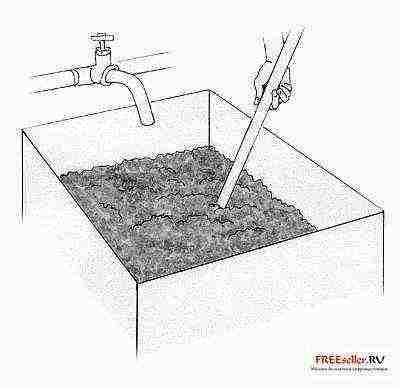
Moistening and stirring the substrate for growing oyster mushrooms in an intensive way.
The waste listed above can be mixed in different proportions, which makes it possible for amateur mushroom growers, on the one hand, to experiment and, on the other, to rationally use the waste of their subsidiary farming.
The substrate is crushed to the size of large sawdust (using a straw chopper). Then add to it 2% (by weight) of ground limestone, 2% gypsum, 0.5% urea, 0.5% superphosphate and water (up to 75% moisture content). To accelerate fruiting and increase the yield, brewer grains or bran are additionally introduced. All these additives should be no more than 10% of the weight of the substrate.
After that, the substrate is pasteurized. Pasteurization is carried out by keeping it for 2-3 hours at a temperature of 80-90 ° C in containers suitable for drying, with stirring. You can also steam the substrate in a small room, keeping it at 55-60 ° C for 12 hours.
Amateur mushroom growers who grow oyster mushrooms in small quantities can process the substrate by pouring boiling water over it in containers and keeping it covered for 2-4 hours.
Then the water is drained, the substrate is dried to the desired (70-75%) moisture content and the mineral additives listed above are added.
Another way to pasteurize the substrate is to fill it with bags (mesh, plastic or burlap) and place them in containers where steam or hot (80-90 ° C) water is supplied. Processing time 6-10 hours.
Thermal treatment of the substrate to eliminate competing molds is essential for all methods. In general, different options for preparing a substrate for growing oyster mushrooms are possible in this way.
After heat treatment, the pasteurized substrate should be gradually cooled and then transferred to the planting site.For growing oyster mushrooms, the substrate can be placed in plastic bags, boxes, flowerpots and other containers, the sizes of which can be varied; the optimal size of bags or boxes is 40 x 40 x 20 cm. The amount of the substrate should be such that it does not dry out too quickly, 5-15 kg. The substrate is slightly compacted. It is very important to keep it clean when placed in a mushroom growing container.
The oyster mushroom mycelium is planted after the substrate has cooled to 25-28 ° C. The mycelium is introduced, evenly stirring it with the substrate, to a depth of 10-15 cm at the rate of 5-7% of the substrate weight: with a lower content of mycelium, the overgrowth of the substrate is delayed and there is a danger of the spread of competing molds.
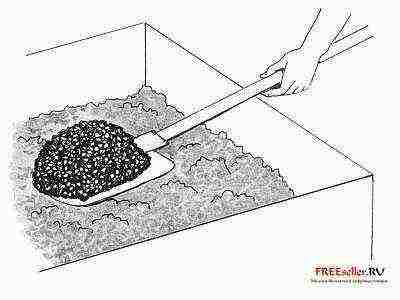
Mixing pasteurized substrate with grain mycelium.
Grain mycelium can be added to the pasteurized, chilled substrate prior to filling the growing containers. In this case, the pasteurized substrate is evenly mixed with sterile mycelium (the same 5-7% of mycelium by weight of the substrate), and then the mixture is placed in containers for growing mushrooms. In this case, a faster and more uniform overgrowth of the substrate is ensured. With this method of introducing mycelium, it is especially important to maintain cleanliness in the premises where this procedure is performed.
Oyster mushroom mycelium grows well and develops at a temperature of 20-; 25 ° C and a relative humidity of 90%. Light is not needed at this time. After 3-5 days, the surface of the substrate should be covered with a whitish layer of mycelium. After 8-10 days, with strict adherence to technology, the entire substrate will first acquire a light brown color, and then intertwine with white mycelium hyphae, which will indicate the beginning of its maturation.

Scoring a plastic bag filled with seeded substrate.
When the mycelium grows, it is necessary to measure the temperature in the thickness of the substrate 1-2 times a day. When it rises to 28 ° C or more, the room should be very well ventilated.
By the end of the period of maturation of the mycelium, which lasts about 20-30 days, the substrate intertwined with the mycelium turns into a dense homogeneous block. These blocks in plastic bags or other containers are transferred to the so-called nursery room, where the temperature is maintained at 12-15 ° C and light is available. You can leave the oyster mushroom culture in the same room, if it is possible to ensure a decrease in temperature and access to light. Oyster mushrooms bear fruit better when the blocks are arranged vertically, therefore they are usually stacked in stacks 80-100 cm high and 40-60 cm wide (you must first remove the blocks from plastic bags). Between the blocks in the stacks, a free space of 90-100 cm is left for easy maintenance and harvesting. The way the blocks are laid depends on the room.
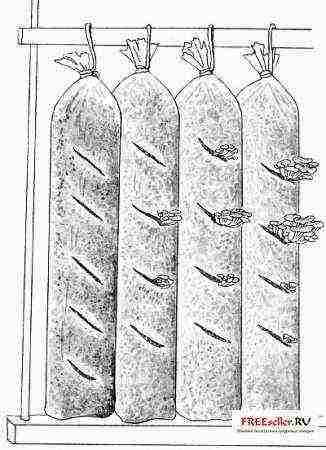
Placing blocks for growing oyster mushrooms on racks with vertical hanging.
Blocks from plastic bags can not be removed, but then, in order for mushrooms to form on all sides of the block, in bags at a distance of 3-4 cm (according to other experimental data 10-15 cm), holes with a diameter of 1-2 cm must be made vertically and horizontally or make vertical or cruciform cuts in the film to expel the formed fruit bodies. Some mushroom growers fix elongated blocks in plastic bags vertically on metal rods or hang them in rows. In boxes and flowerpots, mushrooms appear on the upper, open surface of the substrate. The boxes can also be installed on the end, so that the mushrooms form as if on a vertical wall.
To stimulate fruiting during this period, you can withstand the substrate, permeated with oyster mushroom mycelium, for 2-3 days at a temperature of 3-5 ° C. This procedure is best done before transferring the substrate overgrown with mycelium to the growing room. However, this technique is optional.
The humidity in the room during fruiting must be maintained within 80-100%.For this, at a temperature of 12-16 ° C, 1-2 waterings per day are enough for the floor and partly the walls of the room. If it turns out that the block, taken out of a plastic bag, has dried out a little from the surface, then it can be slightly moistened with a watering can or a hose with a spray.
In recent years, the technology of growing oyster mushrooms has become widespread, when the blocks are not removed from the bags and the room is practically not irrigated, since the substrate contains a sufficient amount of moisture for the formation of mushrooms. Moisture is well retained under the film. In this case, watering in the room is carried out only if the air temperature rises above 18-20 ° C to reduce it.
Fruiting oyster mushroom.
During fruiting, an excess amount of carbon dioxide accumulates in the premises, which must be removed by ventilation.
During the maturation of the mycelium, the first 5-6 days, lighting in the growing room is optional: the main processes occur in the dark in the thickness of the substrate. However, with the appearance of the rudiments of fruiting bodies, it is necessary to create optimal illumination (70-100 lux for 6-10 hours a day).
In a small dark room (basement, shed) use a fluorescent lamp or ordinary sunlight, but shaded. Light affects the structure of oyster mushroom fruiting bodies: mushroom legs are shortened; the caps, which were at first whitish in color, begin to darken and become brownish-gray; as the caps mature, the caps quickly increase in size and brighten again.
Mushrooms should be plucked (it is better to cut them off) from the legs to the base so that the blocks do not start to rot. In 2-3 weeks after the first harvest, the second wave of mushrooms will go. The care of the blocks at this time remains the same, and the lighting system is turned on when the rudiments of the fruit bodies are formed.
Practice shows that up to 75% of the crop is harvested in the first wave, and in total, under optimal conditions and a good substrate, in two waves, the mushroom yield will be approximately 25-30% of the weight of the substrate. It is economically beneficial, especially since the oyster mushroom is well stored, transportable and does not deteriorate at low temperatures.
After the second wave, it is advisable to replace the blocks with new ones overgrown with fresh mycelium. The hatched blocks can be used as roughage for livestock and as a feed additive for poultry. / P>
There are few known oyster mushroom pests and pathogens. Among the pests, mushroom flies are common, as well as ticks and mosquitoes. Diseases, often of bacterial origin, appear after fungi are damaged by pests.
An affordable way to disinfect a room where mushrooms are grown is to spray with a 2-4% solution of bleach or formalin. After that, the room must be closed for two days, and then ventilated for 1-2 days. This treatment must be carried out before each use.
Growing mushrooms at home and in private plots has not yet become common. What for? After all, and so the forests are filled with white mushrooms, mushrooms, chanterelles and boletus mushrooms every autumn. But there are mushrooms that either do not grow in our forests at all, or do it with great reluctance. They can perfectly diversify the menu, and also make good money on them. For example, an oyster mushroom plantation in your own dacha is more than real! It is an ideal mushroom for domestic cultivation. Delicious, inexpensive (in terms of labor costs and the cost of the technological process). Oyster mushroom can be grown in different ways, but there is an option chosen by the time and experience of many amateur mushroom growers.
Growing oyster mushrooms at home
"Children of the Underground"
For the first phase of growing mushrooms, which is their reproduction with the help of mycelium (mycelium), you can do with any ground room - a shed, for example.
The second, main phase is better for mushrooms to "live" in a cellar or basement, that is, underground in the cool.
Growing oyster mushrooms - photo
Both premises for a mushroom plantation must be carefully prepared and equipped with ventilation, electricity and water supply. From the inventory, you will definitely need thermometers to control the degree of heating and cooling of air in the room. The equipment will need a water heater.
By the way! Temperature regulation in a room with growing oyster mushrooms is best controlled by conventional ventilation. To do this, you will have to provide for the possibility of wide opening of windows or doors.
There are several mandatory procedures that must be performed in a building or underground room where mushrooms will grow.
- The premises are whitewashed with lime and then dried using active ventilation.
The walls are whitewashed with lime - photo
- Then the place of cultivation is sprayed with bleach (4% solution).
- After processing, the doors / windows are closed and the inside is left to disinfect for two days.
- Then the object is ventilated for the same amount of time.
- A similar disinfection treatment for conveyor re-cultivation must be performed every cycle.
What mushrooms grow on
Oyster mushrooms differ from their forest counterparts in that they do not grow in soil. They need a substrate for successful growth. You can make a suitable mixture from many components:
- dried straw of field cereals;
- the shell of sunflower seeds is suitable;
- it is very good to use sawdust of trees, but not conifers, but deciduous ones;
- corn stalks, reeds are suitable.
Substrate preparation
All this will become an ideal "soil" for oyster mushroom plantations. The components can be used separately, and it is acceptable to mix them in arbitrary combinations and proportions. The ingredients must be dry. Before use, they need to be crushed (the optimal size of fractions is in the range of 0.5-3 cm). The resulting mixture should have a pleasant odor, not contain traces of mold, fungal debris and foreign objects.
Prepare the substrate on the surface of the earth; this is not necessary in the cellar. For proper preparation and compliance with all regulations, certain procedures must be followed.
- The crushed mass is poured with boiling water until it is completely covered, to destroy all kinds of competing organisms in the form of other varieties or harmful microflora.
Moistening and stirring the substrate
- The substrate thus poured, steamed to the state of "porridge", is tamped into large barrels or other containers suitable for the capacity and left to swell up to half a day.
- Then the mass is taken out of the barrel and laid out for complete cooling and evaporation of some of the moisture on a wide film with a thin layer.
Stage one: mycelium - building up mass
Oyster mushroom mycelium
The preparation is over. Mycelium purchased. You can proceed to the first stage, the task of which is to build up its mass.
Advice! How to check the quality of the mycelium of the oyster mushroom progenitor? He must have some characteristics. Snow-white color, with a small proportion of substrate blotches with a darkish tint. The second parameter is smell. Despite the fact that this mushroom does not grow in the forest, the mycelium should smell like forest mushrooms.
- In a dense transparent polyethylene bag, with a volume of 20 to 60 liters, a layer of wet cold substrate is laid. Layer height - 8 cm. Carefully leveled by hands.
Laying the substrate
- Lay on top, ramming tightly, mycelium, in a three-centimeter layer (you can simply break it into small pieces to tamp without voids).
- Then the substrate is laid and compacted, but already with a layer of 15 cm.
- Again a three-centimeter layer of mycelium.
Mushroom substrate bags
- The procedure should be repeated until all the acquired mycelium runs out. In this case, there should be a substrate layer of 8 cm on top.
- The resulting "puff cake" is compacted, the bag is tied tightly with twine and set in a vertical position.
- The entire surface of the bag is pierced with a long disinfected (can be ignited on fire) nail, 120-150 mm in size. Not every 25 cm² has one hole.
How to make a perforation of a mushroom block
Advice! There should be more holes at the bottom: this is necessary to drain the liquid constantly forming in the package.
Immediately after the procedure, a clear separation of the layers into dark and light (substrate and mycelium) will be visible through the film of the bag.
The temperature required to increase the mycelium mass should be kept at + 18 ... 26 ° С. Germination of mycelium spores will begin in three days, and ten days later you can observe a miracle. The whole mass will turn into mycelium and become completely white. After that, the bag is untied and multiplication is continued to the required amount.
Hanging substrate bags and growing oyster mushrooms
One full standard bag gives life to 8-10 other bags with interlayer (substrate + mycelium). When, finally, the required amount of mycelium for your purposes is formed, then 2 bags from every ten are left for the subsequent increase in mass, and 8 are transferred to obtain the long-awaited harvest of oyster mushrooms.
Fruiting process
Growing oyster mushrooms
The whitened substrate must be kept in the "native" bag for another 5-6 days after ripening, if this bag is sent for fruiting. During this period, it will finally mature, become "monolithic", will be as dense as possible.
To activate the beginning of the crop formation, bags with completely processed substrate mycelium are kept at + 3 ... 5 ° С for another three days. To enable the mushroom fruiting body to grow, it will need room to grow. To create it, holes 3-5 cm in diameter are cut out in polyethylene (one per square meter). The packages are moved to an underground room in temperature conditions of + 10 ... 16 ° С. Here they are installed at a distance of at least 30-40 cm from each other, always vertically. To make it more convenient to water the mushroom "plantation", the bags are placed with ribbons in three rows with a 70 cm gap between them.
Advice! If you are the happy owner of a high basement, then you can also place bags with future mushrooms on additional shelves located along the walls. Such placement will increase the used area, and hence the mushroom yield.
Care for future mushrooms
Once a day, the bags should be slightly moistened, and the room itself should be thoroughly ventilated, since in the process of fruiting oyster mushrooms, a large amount of carbon dioxide is formed. As for the lighting in the dungeon, during the first week it will not be needed at all, and then it would be nice to illuminate the room. Mushrooms will grow in any case - with or without light - but backlighting can significantly increase the yield.
Watering oyster mushrooms
If all conditions are met, the first fruiting will begin in 10 days. When the mushroom heads begin to lighten (after the whitish, dark and greyish brown stages), you can harvest. After a while (about three weeks), the second fruiting will begin with a much lower productivity. Two series of fruiting, taking into account a well-chosen base and high-quality mycelium, yield up to 45 kg of oyster mushrooms from 100 kg of the substrate used. When the harvesting of mushrooms of the second second wave is completed, the packages are taken out of the basement, and, after sanitizing the underground room, a new batch is placed in it. This conveyor method makes it possible to carry out 6 double fruiting cycles per year.
Basic rules for growing oyster mushrooms
Oyster mushrooms grow in a bag of hay
Table. Growing conditions for cycles
| 1 | Germination of mycelium bodies into the substrate | 10-14 | 20-24 | 90 | not required |
| 2 | Ripening and fruiting | 4-5 | 22-28 | 95 | not required |
| 3 | Growth of the fruiting body (1 wave) | 7-10 | 15-19 | 85 | 100 |
| 4 | Growth of the fruiting body (2nd wave) | 7-10 | 13-17 | 85 | 100 |
| 5 | Harvesting, unloading the substrate, disinfection of the chamber | 2 | irrelevant | irrelevant | not required |
Value and use
Fresh Oyster mushrooms
Oyster mushroom is highly valued for its beneficial nutritional properties. In taste, it is not inferior to the rest of the cultivated mushrooms and even surpasses them, and in terms of the value of the composition, it has no competitors at all. Not hard, but dense texture, light bread flavor and subtle aniseed notes on the palate. For cooking - a godsend, since oyster mushroom is a versatile mushroom. It can be boiled, fried, canned (pickled and salted), stewed, dried. The only product that the popular mushroom doesn't go well with is fish. Otherwise, in salad, hot, soups, as a stand-alone culinary masterpiece - oyster mushrooms are wonderful.
Fresh oyster mushroom - photo
Important! A prerequisite for the preparation of any mushroom dishes is its heat treatment. In its raw form, it contains chitin, which is not absorbed and rejected by the human body.
Growing a mushroom, if you have a suitable room and some free time, can become not only a useful and nutritious hobby, but also a way to make good money by supplying healthy and tasty oyster mushrooms to the retail network.
Video - Room for forcing mushrooms Oyster mushroom
Video - Harvesting Oyster mushrooms
